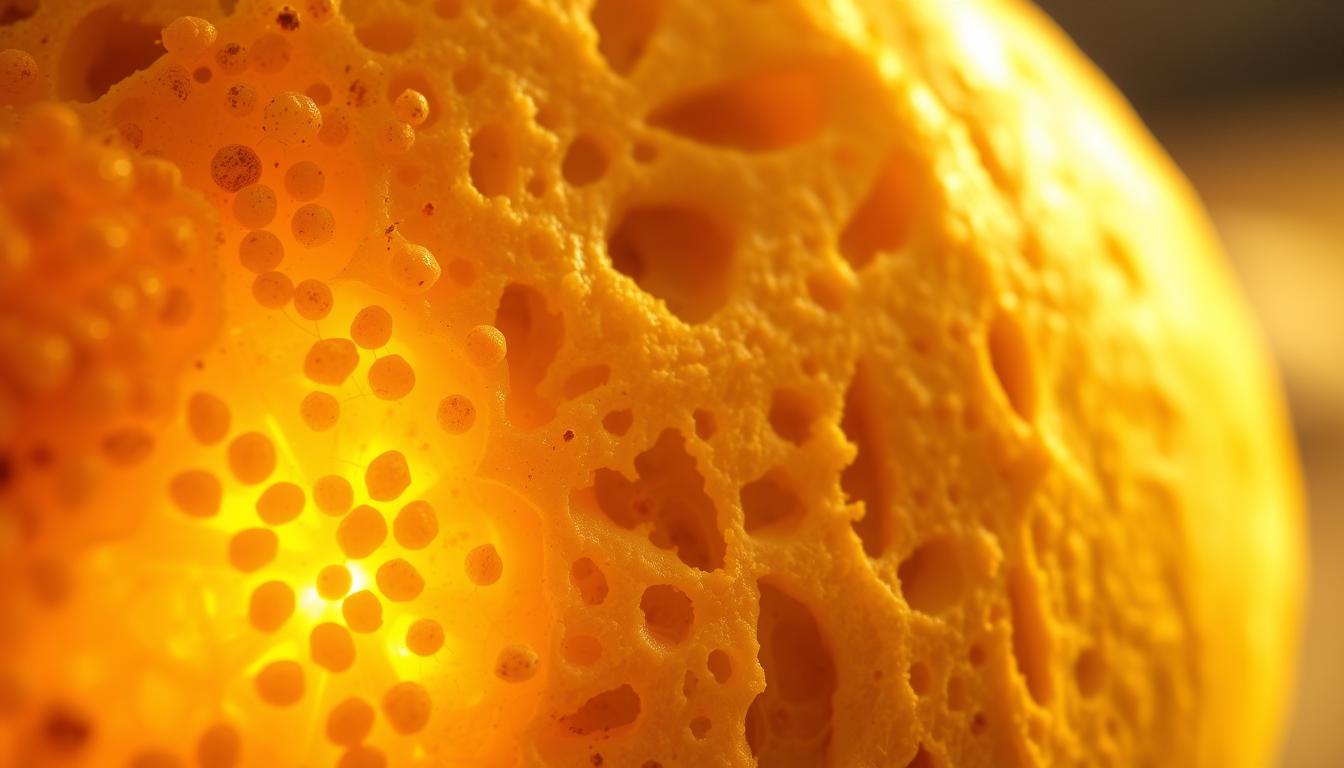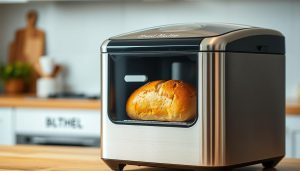One teaspoon of active yeast generates enough carbon dioxide to inflate a party balloon within an hour. This invisible powerhouse transforms dense dough into light, airy loaves through a natural process humans have harnessed for millennia.
The secret lies in how microorganisms interact with simple ingredients. When hydrated, these living cells consume sugars in flour, releasing gas bubbles that expand gluten networks. This partnership between biology and chemistry creates the distinct texture we associate with well-made baked goods.
Without proper fermentation, your final product would resemble flat crackers instead of fluffy sandwich slices. Timing and temperature control prove critical – too little rising leaves dough compact, while overproofing causes structural collapse.
Mastering this balance unlocks consistent results. You’ll learn how different strains affect flavor profiles, why salt regulates activity, and what causes those irregular holes in artisan sourdough. These principles apply whether you’re baking rustic boules or sandwich loaves.
Key Takeaways
- Yeast converts sugars into gas, creating pockets that lift dough
- Gluten development determines how effectively gas gets trapped
- Optimal rising conditions prevent dense or collapsed textures
- Fermentation time directly impacts flavor complexity
- Proper technique ensures consistent results across recipes
Introduction to the Art of Bread Rising
Successful baking hinges on understanding three phases: fermentation, proofing, and leavening. Though often used interchangeably, these terms describe distinct stages where dough transforms from dense mass to airy masterpiece. Mastery begins with precise language.
Unveiling the Mystery of the Rise
Fermentation occurs when microorganisms break down sugars, creating gas and flavor compounds. Proofing refers to the visible expansion as trapped gases stretch gluten networks. Leavening describes the final lift during baking as heat accelerates gas expansion.

Your kitchen environment directly impacts these stages. Cool rooms slow fermentation, while warm spots speed it up. Humidity affects crust formation, and timing determines whether flavors develop fully or collapse under pressure.
Setting the Stage for Success
Control four key variables for consistent results:
- Temperature: 75-78°F ideal for most yeast activity
- Hydration: Balanced water content supports gluten development
- Time: Longer fermentation creates complex tastes
- Handling: Gentle folds preserve gas pockets
Watch for dough doubling in size – the universal sign of proper progression. Sticky surfaces or uneven bubbles signal needed adjustments. With practice, you’ll predict outcomes through touch and sight alone.
The Science Behind Yeast and Fermentation
Every loaf begins with invisible biology. Microscopic organisms work tirelessly to transform simple ingredients into culinary magic. Their activity shapes texture, flavor, and structure through precise chemical interactions.
How Yeast Feeds and Multiplies
These single-cell fungi devour sugars in flour through enzymatic reactions. Warmth and moisture trigger rapid reproduction – one cell becomes millions in hours. This population explosion directly impacts gas production.

Role of Carbon Dioxide in Creating Airy Bread
As yeast metabolizes sugars, it exhales carbon dioxide like miniature factories. These gas bubbles push against dough’s protein framework. Proper kneading ensures these pockets remain trapped rather than escaping.
The Chemistry of Gluten Formation
Flour’s glutenin and gliadin proteins bond when hydrated, forming stretchy networks. Think of it as nature’s balloon animal – flexible yet strong enough to contain expanding gases. Underdeveloped gluten leads to flat, dense results.
Fermentation doesn’t just lift dough. It generates esters and acids that create complex flavors. Balancing time and temperature allows these compounds to develop without weakening the structure.
Essential Ingredients for a Perfect Rise
Your ingredient choices make or break dough’s structural integrity. Two components form the foundation: protein-rich flour and living yeast. Their interaction determines whether your loaf achieves bakery-quality height or remains disappointingly flat.

Choosing the Right Flour for Glutinous Bonds
Not all flours perform equally. Protein percentages dictate gluten potential:
| Flour Type | Protein Content | Gluten Strength | Best Uses |
|---|---|---|---|
| Bread | 12-14% | High | Chewy crusts |
| All-Purpose | 10-12% | Medium | Sandwich loaves |
| Whole Wheat | 13-14% | Low | Dense hearth breads |
| Rye | 8-10% | Minimal | Flatbreads |
Whole wheat and rye contain bran that slices gluten networks. Counter this by blending with bread flour – try 50/50 ratios for better rise. Hydration matters too: whole grains absorb more flour water, requiring adjustments.
Importance of Fresh and Active Yeast
Expired yeast remains the #1 reason for failed dough. Test granules in warm water (105-110°F) before mixing. Active cultures foam within 10 minutes, releasing a nutty aroma. No bubbles? Toss it.
Store yeast in airtight containers below 40°F. For recipes using milk instead of water, heat it to 120°F then cool to 110°F. Dairy fats slow activation, so extra warmth compensates.
Remember: ingredients work as a system. High-protein flour needs vigorous kneading. Slow-acting yeast demands longer proofing. Master these relationships, and every bake becomes predictable.
Mastering Dough Preparation Techniques
Perfecting dough handling separates good bakers from great ones. While quality ingredients matter, technique determines whether your loaf achieves its full potential. Proper manipulation develops the gluten network needed to trap gas and create ideal crumb structure.

Kneading: Building a Strong Gluten Network
Physical manipulation aligns proteins into elastic strands. Press, fold, and rotate dough until it becomes smooth and springs back when poked. The windowpane test reveals readiness – stretch a piece thin enough to see light through without tearing.
Mixer users: 5-7 minutes at medium speed achieves similar results. Overworked dough becomes tough, while under-kneaded versions lack gas retention. Adjust based on hydration – wet mixtures need shorter sessions with periodic rests.
Stretch and Fold Methods to Enhance Structure
High-hydration doughs benefit from gentle handling. Every 30 minutes during fermentation, lift edges and fold toward the center. This technique strengthens gluten without degassing delicate bubbles.
Three folds typically suffice. You’ll notice increased tension and smoother surfaces. This approach preserves complex flavors developed during slow fermentation, making it ideal for artisan-style bread.
Remember: Mixing time directly impacts elasticity. Five minutes of active kneading outperforms two-minute sessions, creating better rise potential. Adapt methods to your recipe’s water content for consistent results.
Why Bread Rises: A Yeast Feast
Your dough’s transformation extends far beyond visible expansion. As microorganisms digest carbohydrates, they produce over 50 flavor compounds that define a loaf’s character. This biochemical ballet occurs through three distinct phases of fermentation.

The Flavor Timeline
Extended fermentation allows complex taste profiles to emerge. Here’s how timing impacts your results:
| Duration | Compounds Formed | Taste Impact | Texture Effect |
|---|---|---|---|
| 2-4 hours | Simple alcohols | Mild, neutral | Uniform crumb |
| 8-12 hours | Organic acids | Tangy notes | Irregular holes |
| 18-24 hours | Esters & ketones | Nutty complexity | Chewy crust |
Rushing the process with excess commercial yeast creates bland results. While tripling yeast amounts speeds gas production, it sacrifices flavor depth. The dough rises faster than taste compounds can develop.
Natural byproducts work synergistically. Lactic acid adds subtle sourness while acetic acid provides sharpness. Alcohols evaporate during baking, leaving aromatic esters that create crust’s distinctive aroma.
Control fermentation speed through temperature adjustments. Cool environments (60°F) stretch the timeline, allowing nuanced flavors to emerge. Warm settings (80°F) accelerate activity but reduce complexity.
Test different proofing durations side-by-side. You’ll taste how extended timelines transform basic wheat flavors into layered profiles with hints of honey, walnut, and dried fruit. Patience becomes your secret ingredient.
Troubleshooting: Overcoming Dough Rise Issues
Even experienced bakers face dough that refuses to rise properly. Three main culprits often sabotage fermentation: environmental factors, ingredient issues, and handling mistakes. Let’s explore solutions for these common frustrations.

Common Pitfalls: Temperature and Environment
Yeast behaves differently in various climates. In chilly kitchens (below 68°F), fermentation slows dramatically. Test liquid temperatures by dipping your finger – it should feel warm but not hot (105-110°F).
| Condition | Effect on Dough | Quick Fix |
|---|---|---|
| Cold Room | Slow rise | Use oven light for warmth |
| Overheated Liquid | Dead yeast | Cool to 110°F before mixing |
| Low Humidity | Crust formation | Cover with damp cloth |
Old or inactive yeast remains a frequent issue. Always proof granules in warm water with a pinch of sugar before adding flour. No bubbles after 10 minutes? Replace your yeast.
Tips to Reactivate Stalled Dough
If your mixture stops expanding, try these revival techniques:
- Place dough in a lightly warmed oven (turn off after 2 minutes)
- Mix 1/4 tsp fresh yeast with 1 tsp sugar and knead into dough
- Check gluten development using the windowpane test
For gluten-related failures, perform stretch-and-fold maneuvers every 30 minutes. This strengthens protein networks without crushing existing gas pockets. With these adjustments, you’ll transform stubborn dough into lofty, well-structured loaves.
Techniques to Control Fermentation Speed
Timing transforms your dough from simple mixture to culinary marvel. Whether you need quick sandwich loaves or artisanal flavor depth, these methods let you dictate fermentation pace without sacrificing quality.
Accelerating Dough Rise without Compromising Flavor
When schedules demand faster results, create ideal conditions for rapid yeast activity. Try these approaches:
- Place dough near appliances emitting gentle heat (cable boxes, refrigerators)
- Mix with warm water (110°F) to jumpstart metabolism
- Add ¼ tsp extra yeast per loaf for quicker gas production
“Speed doesn’t mean blandness – strategic warmth preserves flavor compounds while cutting rise time.”
| Fast Fermentation Method | Time Saved | Flavor Impact |
|---|---|---|
| Steamy bathroom environment | 1-2 hours | Mild tang |
| Extra yeast (up to 2¼ tsp) | 30-45 minutes | Neutral profile |
| Frequent folding | 20 minutes | Enhanced complexity |
Encouraging a Slow Fermentation for Depth
Cold environments let flavors develop intricate layers. Retard fermentation by:
- Chilling mixed dough overnight (34-38°F)
- Using 50% less yeast than standard recipes
- Mixing with ice water instead of room-temperature
Three-day cold fermentation boosts acidic notes by 40% compared to quick rises. This method suits sourdough enthusiasts and busy bakers alike – prepare dough Sunday night, bake fresh loaves Wednesday morning.
Comparing Leavening Agents in Bread Making
Your choice of rising agents shapes both texture and flavor in baked goods. Different methods create distinct results – from quick chemical reactions to slow biological processes.
Yeast vs. Baking Powder and Baking Soda
Baking powder and baking soda work through acid-base reactions. They release carbon dioxide instantly when mixed with liquid. This suits recipes needing immediate lift like pancakes or muffins.
Yeast acts slower, feeding on sugars over hours. This extended fermentation builds complex flavors. Chemical leaveners lack this depth but offer convenience for time-sensitive bakes.
Understanding Sourdough Starters for Ultimate Taste
Natural sourdough uses wild yeast and bacteria. These cultures produce tangy notes absent in commercial yeast. Maintaining a starter requires regular feeding but rewards with unparalleled aroma.
For artisanal results, combine slow fermentation with high-protein flours. Your patience gets repaid in crusty exteriors and irregular, flavorful crumb structures.



